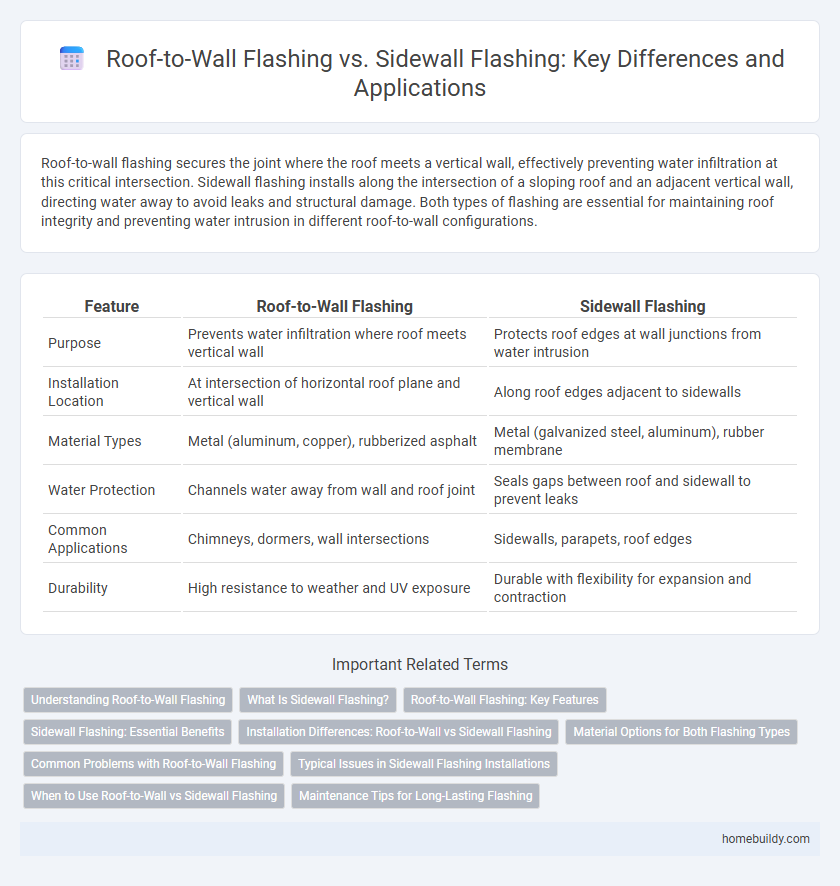Roof-to-wall flashing secures the joint where the roof meets a vertical wall, effectively preventing water infiltration at this critical intersection. Sidewall flashing installs along the intersection of a sloping roof and an adjacent vertical wall, directing water away to avoid leaks and structural damage. Both types of flashing are essential for maintaining roof integrity and preventing water intrusion in different roof-to-wall configurations.
Table of Comparison
| Feature | Roof-to-Wall Flashing | Sidewall Flashing |
|---|---|---|
| Purpose | Prevents water infiltration where roof meets vertical wall | Protects roof edges at wall junctions from water intrusion |
| Installation Location | At intersection of horizontal roof plane and vertical wall | Along roof edges adjacent to sidewalls |
| Material Types | Metal (aluminum, copper), rubberized asphalt | Metal (galvanized steel, aluminum), rubber membrane |
| Water Protection | Channels water away from wall and roof joint | Seals gaps between roof and sidewall to prevent leaks |
| Common Applications | Chimneys, dormers, wall intersections | Sidewalls, parapets, roof edges |
| Durability | High resistance to weather and UV exposure | Durable with flexibility for expansion and contraction |
Understanding Roof-to-Wall Flashing
Roof-to-wall flashing is a critical roofing component designed to prevent water infiltration where a roof intersects a vertical wall, ensuring a watertight seal between the roof deck and wall surface. Unlike sidewall flashing, which primarily manages water runoff along the sides of the roof, roof-to-wall flashing must accommodate both vertical and horizontal water flow, requiring precise installation of materials such as metal or rubberized membranes. Proper understanding and installation of roof-to-wall flashing significantly reduce the risks of leaks, structural damage, and mold growth, enhancing the overall durability and performance of roofing systems.
What Is Sidewall Flashing?
Sidewall flashing is a critical waterproofing component installed where a roof meets a vertical wall, preventing water infiltration at this junction. Unlike roof-to-wall flashing, which specifically covers the intersection between a roof surface and a wall, sidewall flashing extends along the vertical wall surface to direct water away from the structure. Properly installed sidewall flashing uses materials like metal or flexible flashing tape to create a durable barrier against leaks and water damage.
Roof-to-Wall Flashing: Key Features
Roof-to-wall flashing is designed to seal the junction where the roof meets a vertical wall, preventing water infiltration and protecting structural integrity. Key features include a metal or flexible membrane material that conforms tightly to surfaces, ensuring a watertight barrier and durability against weather conditions. This type of flashing typically integrates with roofing underlayment and siding to create a continuous shield against moisture.
Sidewall Flashing: Essential Benefits
Sidewall flashing provides a critical waterproof barrier where a roof intersects with a vertical wall, preventing water infiltration that can cause structural damage and mold growth. Its design directs runoff away from vulnerable joints, enhancing the durability of the building envelope. Proper installation of sidewall flashing extends roof lifespan and maintains the integrity of both roofing and wall systems.
Installation Differences: Roof-to-Wall vs Sidewall Flashing
Roof-to-wall flashing requires precise integration with roofing materials to create a watertight seal where the roof plane meets a vertical wall, often involving step flashing and counter flashing techniques. Sidewall flashing installation focuses on sealing joints at the intersection between the roof edge and an adjacent vertical sidewall, emphasizing overlapping metal pieces to direct water away from vulnerable points. Correct installation of both types is critical to prevent water infiltration and structural damage, but roof-to-wall flashing demands more complex layering due to the angled roof surface.
Material Options for Both Flashing Types
Roof-to-wall flashing and sidewall flashing require durable materials to prevent water infiltration where different roof planes meet or where the roof intersects with a vertical wall. Common material options for both include galvanized steel, aluminum, copper, and lead, chosen for their corrosion resistance and flexibility to conform to various roof and wall profiles. Synthetic rubber membranes and flexible vinyl options are also gaining popularity for superior waterproofing and ease of installation in both flashing applications.
Common Problems with Roof-to-Wall Flashing
Common problems with roof-to-wall flashing include water infiltration due to improper installation, inadequate sealing, and damage caused by thermal expansion and contraction. These issues often lead to leaks, wood rot, and mold growth along the roof-to-wall junction. Maintaining durable materials like aluminum or copper and ensuring professional installation can significantly reduce these risks.
Typical Issues in Sidewall Flashing Installations
Common issues in sidewall flashing installations include improper integration with siding materials, leading to water infiltration and premature deterioration. Incorrect slope or insufficient overlap can cause water to pool, increasing the risk of leaks and damage to the wall structure. Failure to use compatible sealants or flashing materials often results in gaps and corrosion, compromising the flashing's effectiveness.
When to Use Roof-to-Wall vs Sidewall Flashing
Roof-to-wall flashing is used where the roof surface intersects a vertical wall, preventing water infiltration at the junction by directing water away from the seam. Sidewall flashing is installed along the side of a wall where it meets a roof or another wall, primarily serving as a barrier against lateral water intrusion. Choose roof-to-wall flashing for horizontal roof-to-wall connections and sidewall flashing for vertical or angled wall intersections to ensure optimal waterproofing.
Maintenance Tips for Long-Lasting Flashing
Regular inspection of roof-to-wall flashing and sidewall flashing is essential to identify cracks, rust, or loose seams that could lead to water infiltration. Applying high-quality sealant around the edges enhances waterproofing and prevents damage from wind-driven rain or snow. Cleaning debris and ensuring proper drainage near flashing areas extends the lifespan and maintains the structural integrity of the roofing system.
roof-to-wall flashing vs sidewall flashing Infographic

 homebuildy.com
homebuildy.com